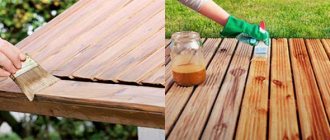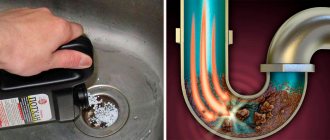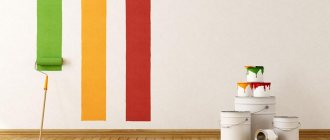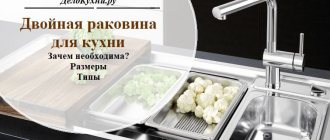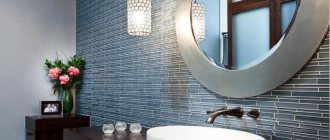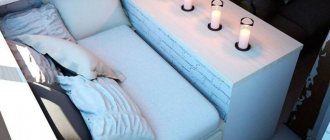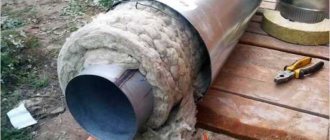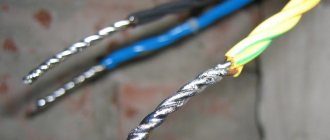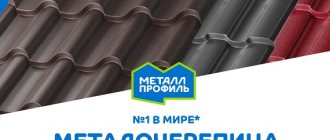- Reasons for appearance
- Why is it dangerous?
- How to eliminate: best methods How to remove mold from silicone in the bathroom using special products
- How to remove mold from sealant in the bathroom: traditional methods
- Silicone based
To prevent leaks in the bathroom, use sealant. Mold, during operation, penetrates the material, changes its color, and has a destructive effect.
Reasons for appearance
Mold is a lower organism that reproduces by spores. They are present in the air in small quantities, but under certain conditions they begin to actively spread. This is why it is important to know why mold appears in the bathroom and how to get rid of it. The settled particles begin to grow under the following conditions:
- air temperature > +20ºС;
- humidity > 90-95%;
- insufficient level of ventilation in the room;
- constant local accumulation of moisture;
- poor hygiene.
When the humidity in the bathroom is high, condensation forms on the wall. It flows down in the form of drops. Areas of increased moisture accumulation in the bathroom occur in the lower part of the wall, where mold often appears on the seams of the sealant.
Note! For the surface to dry, the water must evaporate. This process takes several hours. There is constant long-term exposure to moisture, which causes mold growth, since fungus does not grow in dry air.
Mold forms on any surface: wood, plastic, metal, silicone, ceramic tiles. If the material is dense and the fungus cannot penetrate inside, it settles and grows on the surface. Mold can be white, brown, or red. Black is found on the sealant.
What is the difference between them?
Silicone sealants are the most popular, the highest quality and, unfortunately, the most expensive. This type, due to its characteristics, is suitable for absolutely any type of bath. Its features are excellent resistance to moisture and ultraviolet rays.
Silicone sealants are either acidic or neutral. The former are also called vinegar because of their specific smell. Acidic ones are much cheaper than neutral ones, but have many disadvantages. The main one is the ability to vulcanize. Because of this, they are not suitable for all types of baths.
In general, silicone sealants are almost ideal; blackening is not typical for them, but you will have to pay a little more for such pleasure.
Acrylic sealants are also distinguished by their high quality and resistance to various conditions. The species has a high temperature range (from -25 to +80). But its seam is not particularly elastic, which can give rise to a number of problems when it comes to deformed joints.
Polyurethane sealants create an elastic and reliable seam that can easily withstand deformation. For safety reasons, it is recommended to work with such a substance wearing a mask or gloves.
Why is it dangerous?
Mold feeds on organic remains and breaks down complex substances into simple compounds.
The negative impact of the fungus manifests itself as follows:
- by feeding on organic matter, it contributes to the destruction of materials;
- spoils the appearance of the finish;
- releases spores that infect new areas;
- causes aspergillosis;
- has a toxic effect, accumulating in the human body.
Forming on sealant and tile joints, mold penetrates deeper. Moving onto load-bearing structures made of concrete, slag, plasterboard, wood, the fungus makes them loose.
Criteria for choosing wisely
You should not skimp when choosing a sealant. Preference is given to polyurethane, silicone and MS sealants, which include additives that increase their moisture resistance and resistance to fungi. In this case, the content of additives should not exceed 10% of the total volume. Various additives should not affect the quality of the insulation.
Preference should be given to proven products. Before purchasing a material, you need to study its instructions and release date. An expired product should not be purchased. It is better to buy materials in stores. In markets, materials are exposed to temperatures and may be stored in inappropriate conditions. This may affect their quality characteristics.
How to fix: best methods
Removing mold on silicone in the bathroom begins immediately. A number of remedies can both eliminate the cause of its appearance in the form of blackheads and prevent further spread. The compositions are aimed at destroying the spores and stems of the pest.
For work you will need:
- protective equipment (gloves, goggles, overalls, respirator);
- devices for cleaning the surface (brush, rags);
- tools for applying the composition (brush, sponge, spray).
Depending on the concentration, antiseptics have a deep and superficial effect.
If the sealant is completely damaged, it is removed and the freed surfaces are cleaned. Treated with disinfectants and protective substances. After this, the seams are insulated again.
How to remove mold from silicone in the bathroom using special products
Hardware and construction stores sell ready-made compounds that act on mold. You can choose a good composition from the following list:
- Prosept Fungi - affects mold, moss, lichen. The product is applied with a sponge or spray. A few minutes are enough for an easy effect. Deep effects and destruction of fungi are achieved by keeping the product for 1-3 days. You can use the bath after washing the treated surface.
- Biotol - used to prevent the formation of fungus and eliminate it. Used at temperatures above +5ºС. Untreated adjacent surfaces are protected with plastic film. For an effective effect, the substance is left for 1-2 days. After cleaning, you can use the room.
- Neomid - removes mold from mineral surfaces. Exposure time is 15-30 minutes. The use of special protection is mandatory. The composition tolerates freezing. The thawed substance must be shaken before use.
- Feidal - designed for processing any surfaces. Does not contain chlorine, safe for humans. Cleaned surfaces can be treated for several hours. If necessary, repeat the treatment.
- Cillit Bang is available for purchase at hardware stores. Not used on surfaces made of marble, brass, copper, textiles, linoleum. When applied, a foam is formed that penetrates the surface. The composition has a shallow effect. Exposure time up to 15 minutes. Next, the product must be washed off with water.
- Hypochlorite-based products: Bagi anti-mold, Domestos, whiteness. The compositions have antifungal activity. Whitens any surfaces. Use with caution on sanitary enamels of bathtubs and shower stalls.
The choice of product is based on its toxicity and the depth of damage to the surface. Chemical compositions are used according to the instructions.
How to remove mold from sealant in the bathroom: traditional methods
Household compositions are prepared from available ingredients.
- Copper sulfate is a blue crystalline powder. It is diluted in the ratio: 1 part powder to 10 parts water. After mixing, the solution is used to treat areas affected by mold. Large surfaces are sprayed with a spray bottle. If you need to process only the seams, use a brush, sponge, brush. After 2 hours, the substance is washed off. The drug is toxic and causes poisoning. Be sure to use a respirator and gloves.
- Vinegar and baking soda can be applied separately or mixed together. The gruel, powder or liquid is applied to the seams using improvised means. Leave to act for 5-10 minutes. Next, wash with water.
- Hydrogen peroxide also works well to whiten surfaces. Before processing, it is necessary to move and remove all textile and rubber items. If liquid gets on the fabric, it will leave white marks. Peroxide is applied locally for a few minutes, then washed off with water.
- Ammonia. It is used not only for medical, but also for household purposes. One teaspoon is diluted in a glass of water and the surface is treated.
- Solutions with boric acid. There are two recipes. In one of them, 10 g of acid, 100 g of salt and 0.5 liters of water are mixed. In the second, you will need to combine 1 glass of water, 50 g of boric acid, 100 ml of vinegar, 100 ml of peroxide. The mixture is applied to the infected areas for 15 minutes. Then everything is washed off with water.
- Tea tree oil is a natural, powerful antiseptic. A solution (10 ml of oil per 0.5 liter of water) is applied to the walls. You don’t have to wash it off, but you will need to ventilate the room.
- Lemon acid. You will need to squeeze lemon juice and apply it to the walls. Or dissolve the powder in the amount of 1 teaspoon per half liter of water. Finish the seams.
The advantage of homemade recipes is that their preparation does not require expensive substances or special preparation.
Use of household chemicals
You can quickly solve the problem using chemicals. They are sold in hardware departments. The most popular are:
- Сillit Bang anti-stain. To remove black fungus, just apply the product for 5 minutes.
- ASTONISH Mold & Mildew Remover. The active ingredient is chlorine. It effectively removes mold. There is no need to rub or wait a lot of time. You need to moisten a sponge with the product, lightly rub it over the surface and leave for 3 minutes. Then wash off.
- Veksa Bathroom cleaner. The product is not diluted, but immediately applied to the sealant. For greater effectiveness, it is worth wiping the area with a brush.
Mold Removal
Mold Resistant Sealants
Sealant is an insulating material in the form of a gel or paste. It is used at the joints of structures. In order to prevent the formation and spread of mold, antibacterial additives are added to them.
Silicone based
The best anti-mold bathroom sealant is made from rubber.
The material is popular due to its excellent physical and chemical properties:
- resistant to detergents, acids, alkalis, oils, alcohols, ultraviolet radiation, radiation;
- withstands temperature range -50 + 200ºС;
- moisture resistant;
- differs in adhesion on many surfaces of glass, wood, plastics, metal, enamel;
- produced in different colors.
Silicone compounds are divided into two types:
- Acidic, containing acetic acid. They are affordable and dry quickly. But they emit vapors that are harmful to humans and lead to oxidation of metal surfaces.
- Neutral - safe for humans. Can be used on any materials, including acrylic. They cost more than acidic ones.
KIM TEC Silicon 101E is a durable silicone sealant-adhesive on an acetate base with additives resistant to microorganisms. Polymerizes in air into a rubber compound. Not for use with materials sensitive to acetic acid, polyethylene and films. Viable at temperatures -50...+180 ⁰С. Designed to work with plumbing and craft materials. Can be used indoors in swimming pools.
Pufas Silikon Fugendicht - suitable for sealing wide joints with a thickness of up to 25 mm. Curing time 3 mm per day. Elastic, stretch up to 25%. Applicable to all materials except stone and galvanized metals. Has fungicidal additives against mold formation.
Moment sealant sanitary - designed for sealing seams, joints, voids in bathrooms, kitchens, showers, glazing frames. For gluing parts made of ceramics, metal, wood. The one-component silicone composition has antiseptic additives against mold. Can be used indoors and outdoors. Resistant to chemicals and water, elastic.
For wet rooms, a sanitary sealant with fungicidal additives is used that is resistant to the formation and spread of mold.
Acrylic based
Acrylic-based sealants vary in their degree of moisture resistance. Non-moisture-resistant material is additionally protected with pastes.
Pros of acrylic:
- hardens quickly and gains maximum strength within 24 hours;
- diluted with water to the desired consistency;
- non-toxic, odorless;
- UV resistant;
- does not turn yellow;
- Cured plastic is easy to dismantle.
Minuses:
- in solid form it is not plastic;
- with prolonged exposure to moisture, it peels off from the surface.
Pufas Acryl Fugendicht A30 is an acrylic sealant with fungicidal additives. Flexible and waterproof once completely dry. Suitable for wet rooms when working with concrete, plasterboard, ceramic tiles.
Tekadom Acryl Profi - suitable for sealing in mineral materials and wood. The seams that have gained strength are tensile by 15%. Before compaction, the surfaces are cleaned of dirt and may be damp.
VGT sanitary acrylic - used in bathrooms, showers, when processing seams in materials made of glass, wood, ceramics, metal, PVC. The room must be dry during operation. The sealant is not suitable for sealing areas where there is constant accumulation of water. The strength of the connection is achieved within 24 hours.
One-component acrylic materials are not used in damp rooms in places where water accumulates.
Based on acrylic silicone
Acrylic silicone sealant is a two-component material. Available in transparent or colored.
It is moisture resistant, but just like one-component, it peels off with prolonged exposure to water. The composition includes antifungal additives. Suitable for wet rooms, bathrooms, provided there is no direct contact with liquids.
It is applied with a thickness of 5-6 mm. The prepared surface must be clean and always dry. Moisture is allowed to enter the surface after complete hardening.
Fome Flex silacryl is a silacrylic sealant with antifungal additives. Used as a sealant for shower cabins, bathtubs, tiles. Odorless, tolerates moisture well, resistant to fungus. It is used in shallow seams, as it hardens slowly 1-2 mm per day. Can be painted after drying.
Auster silacryl differs from the previous sealant in that it is not suitable for use in areas with large accumulations of moisture. Also has anti-mold additives.
Polyurethane based
Polyurethane sealant is developed on the basis of polymers. Used for sealing new and old surfaces after repairs. Dries in 12 hours.
Positive properties:
- adhesion on any materials (ceramics, concrete, enamel, plastic);
- moisture resistance;
- maintainability;
- long service life.
They produce one- and two-component polyurethane sealants. For polymerization of the former, the presence of oxygen is necessary. The second contains a hardener.
These sealants can be used to fill deep seams that, when dry, resemble rubber. The material is used not only for insulation, but also for gluing surfaces. It is used to glue plastic or metal baseboards in the bathroom. The adhesive layer can be adjusted and imperfections can be eliminated within 20 minutes.
Polyflex 442 is a medium-modulus sealant for interior and exterior use. Tolerates exposure to fresh and salt water, grease, and cleaning agents. Elastic, used in expansion joints.
Tytan power flex - silanized polymer, adhesive. Suitable for gluing porous and non-porous materials (glass, stone, metal, plastic). Forms a strong, elastic, waterproof seam. Cures 4 mm per day.
Rubberflex PRO PU-25 - for sealing joints of building structures made of concrete, metal, wood. Withstands temperatures -60…+90ºС. Tolerates precipitation and moisture well. Forms a strong elastic connection, has good adhesion to concrete, granite, glass, wood, PVC. Does not require preliminary priming of the surface and can be painted.
Before applying any sealant, the surface is cleaned and dried. After installation, protect the surface from dust, moisture and dirt until the seal is completely dry.
Which to choose?
Silicone, acrylic-silicone, polyurethane sealants are used in places where water accumulates. Neutral seals are universal, chemically resistant, suitable for any materials. Acetate-based compounds are not used on materials that are vulnerable to acetic acid.
Deformation movable joints are filled with polyurethane sealants, as they have high elongation. Holds well in wide cavities 6-25 mm.
Acrylic sealants are the weakest. They do not stretch well and require low air humidity during work. Used to fill joints in mineral materials.
Each category produces products with antibacterial additives.
User voting
Which sanitary sealant would you choose or recommend?
Ceresit CS 25
16.67 % ( 1 )
Makroflex SX101 Sanitary
0.00 % ( 0 )
Belinka Belsil Sanitary Acetate
0.00 % ( 0 )
Quelyd 007 Crystal Clear
16.67 % ( 1 )
Moment Germent Sanitary
16.67 % ( 1 )
MasterTeks PM universal
0.00 % ( 0 )
Ravak Professional X01200
33.33 % ( 2 )
Dow Corning 7091
0.00 % ( 0 )
Tangit S 400
16.67 % ( 1 )
Preventive measures
Every housewife needs to understand that something urgently needs to be done if the sealant or silicone in the bathroom turns black. It is better to prevent the appearance of mold in advance than to get rid of it later. Mold spores are drought and freeze resistant. If the plaque has penetrated deeply into the finish, it will have to be cleaned off.
The following preventive measures are applied:
- at the repair stage, materials with anti-mold additives are selected;
- thoroughly ventilate and dry the room;
- properly arrange the ventilation system;
- use dehumidifiers if necessary;
- accumulated contaminants are removed in a timely manner.
Important! To reduce humidity, do not dry wet laundry in the bathroom.
Even after successful removal of the infestation, if precautions are not taken, mold will reappear.
How to choose a bathroom sealant that won't turn black
Today, bathroom sealants are gaining popularity faster and faster. Such substances quickly and efficiently seal many different cracks in the bathroom and help improve its overall condition.
However, you need to understand that the bathroom is a place characterized by significantly increased humidity. Many substances may simply not cope with such strength tests and succumb to certain defects, for example, blackening.
Few people would like to face such a problem, so it is better to take appropriate measures before an unpleasant situation occurs. The most logical thing to do is to immediately choose high-quality material.
Conclusion
Fungus on metal and plastic is a resilient organism. Its growth takes place actively in damp areas, such as the bathroom. On finishing materials, the fungus appears in the form of spots, and the sealant gradually turns black. Recommendations on how to get rid of mold on sealant in the bathroom:
- Completely contaminated surfaces are dismantled.
- To prevent the formation of mold in the bathroom, building materials with antibacterial additives are used.
- The resulting fungus is removed with ready-made chemical compounds and folk remedies. Copper sulfate, vinegar, citric and boric acid, soda, and hydrogen peroxide are used.
- The bathroom is ventilated, humidity is monitored, and cleanliness is maintained.
If you notice the problem in time and start fighting, you can stop the growth and further spread of the pest.
What materials and tools are needed to work with sealant?
The system for surface protection and mold removal should include the preparation of material as well as tools. To work independently you will need to prepare:
- A special gun, if selected for surface treatment;
- Rubber spatula;
- Rags;
- Masking tape;
- Acetone.
The system for surface protection and mold removal should include the preparation of material as well as tools.

